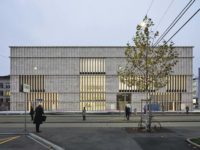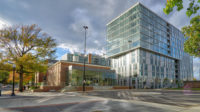Fittingly, The Japan Sword Museum sits amid the Kyu Yasuda Garden, a public park that once belonged to an 18th-century Samurai estate. Famous warriors during the country’s pre-Modern era, Samurai were leading patrons of swordsmiths who forged the bow-shaped, single-edged blades, each one a lethal weapon and an exquisite work of art. Though swords in Japan had become merely ornamental by the end of the 19th century, many were confiscated by the Allied Occupation forces following World War II. Fearing their extinction, the Society for the Preservation of Japanese Art Swords was founded in 1948 for the purpose of collecting, displaying and appraising the blades and related accoutrements. Conveniently, the availability of this pond-side property, where the Ryogoku Public Hall built in 1926 once stood, coincided with the organization’s recent need for a new building. For the design of this facility, they turned to Maki and Associates.
Additional Content:
Credits & Specifications
Bowing politely to the historic hall, Maki used its footprint as a guideline for the museum: a three-story structure oriented towards the garden’s pond. The building is entered from the site’s northwest corner where angled walls welcome visitors inside. Within the museum, the first floor is divided by a cross-shaped circulation space into quadrants containing an information corner, museum shop, auditorium, and café–all open to neighborhood folk and tourists alike. Stairs on either side lead up to the curatorial offices, storage area, and conference room on the second floor. The top floor holds the exhibition hall and a wrap-around terrace overlooking the garden and its pond. Echoing the dome of the old hall, a curved metal roof caps the gallery and crowns the building.
Blending comfortably with the greenery, exposed concrete and cedar trim are the main exterior materials. But inside an array of textures and colors sets the stage for the museum’s artifacts. While metallic stucco lines the lobby’s curved walls, billowy, fabric lighting fixtures are recessed into its ceiling. Contrasting with the softness of these elements, the stairs’ steel panels and handrails anticipate the fine metalwork in the gallery, a semi-dark room where LED uplights dramatically illuminate the vaulted ceiling while LED spotlights focus on the individual pieces.
In recent years, Maki and Associates have designed many large-scale projects around the globe, including New York’s 4 World Trade Center. Tiny by comparison, The Japan Sword Museum has been treated with the same care and close attention, resulting in a jewel box of a building.













Post a comment to this article
Report Abusive Comment